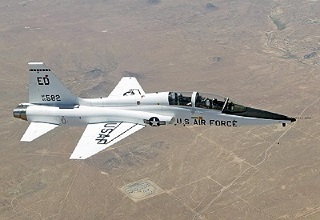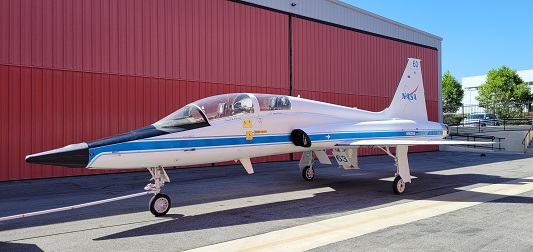|
The Northrop T-38 Talon is a two-seat, twin-engine
supersonic jet trainer. It was the world's first supersonic jet
trainer and is also the most produced. The T-38 remains in service
as of 2021 in several air forces.
In 1952, Northrop began work on a fighter project
the N-102 Fang, with a shoulder-mounted delta wing and a single-engine.
The proposed General Electric J79 engine, weighing nearly two
tons, meant the resulting aircraft would be large and expensive.
In 1953, representatives from General Electric Aviation's newly
created Small Aircraft Engine Department showed Northrop an engine
that was approximately 400 lbs installed weight, capable of 2,500
lb of thrust. Northrop VP-Engineering, Edgar Schmued, saw the
possibility of reversing the trend toward the large fighters.
Schmued and chief engineer, Welko Gasich, decided on a small
twin-engine "hot-rod" fighter, the N-156. Northrop
began its N-156 project in 1954, aiming for a small supersonic
fighter jet capable of operating from the US Navy's escort carriers.
However, when the Navy chose not to pursue equipping its fleets
in that fashion, Northrop continued the N-156 design using in-house
funding, recasting it as a lightweight fighter (dubbed N-156F)
and aimed at the export market.
In the mid-1950s the USAF issued a General Operating
Requirement for a supersonic trainer, planning to retire its
1940s-era Lockheed T-33s. Northrop officials decided to adapt
the N-156 to this competition. The only other candidate was the
two-seat version of the North American F-100 Super Sabre. Although
the F-100 was not considered the ideal candidate for a training
aircraft as spin recovery was less then satisfactory, NAA was
still considered the favorite in the competition due to that
company's favored-contractor status with the Air Force. However,
Northrop officials convincingly presented life-cycle cost comparisons
which could not be ignored, and they were awarded the contract,
receiving an order for three prototypes. The first (designated
YT-38) flew on 10 April 1959. The prototype was quickly adopted
and the first production examples were delivered in 1961, officially
entering service on 17 March that year, complementing the T-37
primary jet trainer. When production ended in 1972, 1,187 T-38s
had been built (plus two N-156T prototypes). Since its introduction,
it is estimated that some 50,000 military pilots have trained
on this aircraft. The USAF remains one of the few armed flying
forces using dedicated supersonic trainers, as most, such as
the US Navy, use high subsonic trainers.
The T-38 is of conventional configuration, with
a small, low, long-chord wing, a single vertical stabilizer,
and tricycle undercarriage. The aircraft seats a student pilot
and instructor in tandem, and has intakes for its two turbojet
engines at the wing roots. Its nimble performance has earned
it the nickname white rocket. In 1962, the T-38 set absolute
time-to-climb records for 3,000, 6,000, 9,000 and 12,000 meters,
beating the records for those altitudes set by the F-104 in December
1958. (The F-4 Phantom beat the T-38's records less than a month
later.)
The F-5B and F (which also derive from the N-156)
can be distinguished from the T-38 by the wings; the wing of
the T-38 meets the fuselage straight and ends square, while the
F-5 has leading edge extensions near the wing roots and wingtip
launch rails for air-to-air missiles. The wings of both the T-38
and the F-5 family use conventional skin over spar-rib structure.
Most T-38s built were of the T-38A variant, but
the USAF also had a small number of aircraft converted for weapons
training (designated AT-38B), which were fitted with a gunsight
and could carry a gun pod, rockets, or bombs on a centerline
pylon. As of September 30, 2017, 503 T-38s were still operational
with the USAF, with many more in operation around the world.
Most of the USAF variant aircraft (T-38A and AT-38B) have been
converted to the T-38C through an avionics upgrade program. Improvements
include the addition of a HUD, GPS, INS (Inertial Navigation
System), and TCAS. Most T-38's have also received a propulsion
modification to enlarge the engine inlet area and significant
thickening of the inlet, this design promotes laminar flow of
incoming air, increasing aircraft efficiency and engine thrust.
The exterior engine inlet profile was customized for maximum
aerodynamic performance and to maintain continuity with existing
aircraft structures. The T-38's that experience more severe usage
are currently undergoing structural replacements and upgrades,
as well as receiving new wings, to extend their service life
to 2029.
The fighter version of the N-156 was eventually
selected for the US Military Assistance Program and produced
as the F-5 Freedom Fighter. Many of these have since reverted
to a weapons training role as various air forces have introduced
newer types into service. The F-5G was an advanced single-engined
variant later renamed the F-20 Tigershark. In 2018, the Iranian
Air Force announced that an outwardly-similar aircraft, named
the Kowsar, had been constructed within Iran.

Photo left of the first production T-38 built for
the U.S Air force to roll off Northrop Grumman's aircraft assembly
line in Hawthorne. This T-38 trainer began life as an Air Force
T-38 trainer with tail number 59-1603 and was officially delivered
to the Air Force on January 31, 1961. N963NA can be viewed at
the Western Museum of Flight in Torrance, California. N963NA,
had spent its last 16 years training NASA shuttle pilots.
Over the next 45 years, its journey as a trainer aircraft included
stops at many military installations around the country, including:
1962 -- Delivered to Randolph AFB, Texas, to serve as Air Force
Training Command's primary supersonic trainer.
1964 -- Sent to Dobbins AFB, Georgia, to serve as a chase plane
for newly designed aircraft.
1966 -- Transferred along with three other T-38s to Los Angeles
International Airport to help train astronauts for Manned Orbiting
Laboratory missions.
1969 -- Returned to Edwards AFB, Calif., to serve as a chase
plane and to help maintain pilot proficiency.
1972 -- Transferred to China Lake Naval Weapons Center with the
intention of making it into a drone, or unmanned target aircraft,
capable of being operated by radio control.
1974 -- Entered service at Navy's Top Gun air combat training
program at Miramar Naval Air Station, San Diego. In this role,
T-38 and pilot mimicked Soviet fighter aircraft to help train
Navy aviators in air-to-air combat techniques.
1976 -- Returned to China Lake Naval Weapons Center where its
rear cockpit received drone equipment. Over the next ten years,
served as an air-to-air radar target, a chase plane, and pilot
proficiency plane, participating in both manned and unmanned
missions.
1987 -- Transferred to Fallon Naval Air Station, Nev., to serve
as a pilot proficiency aircraft.
1989 -- 1991 Transferred to NASA, then underwent complete renovation,
including replacement of key structural components; installation
of new wings, new landing gear, improved ejection seats and radar
altimeter; significant rewiring of the cockpit and nose sections;
and replacement of its canopy and windshield.
1991 -- Returned to service as a trainer aircraft for NASA astronauts.
2007 -- Retired from active duty and returned to Northrop Grumman
for long term static display.
Northrop Grumman has been producing replacement
wings for T-38 trainers since the 1980s. A redesigned wing that
went into production in 2006 will be used to retrofit the entire
fleet. The new wing, which the company is producing in its El
Segundo aircraft manufacturing facility, is expected to extend
the operational life of T-38s to approximately 2040.
Home |